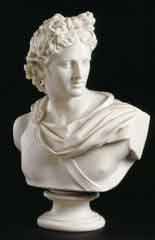Groundbreaking virtual catalogue will put 3-D images of works of art online

Bust of Apollo made in porcelain at the Copeland Factory, 1861. Copyright V&A Museum, London
Museum curators and researchers who need to view historical artefacts or works of art in museums and galleries such as the Louvre, the Uffizi and London’s National Gallery, should be able to save on their plane and train fares thanks to a unique project being undertaken by computer scientists at the University of Southampton.
The project, known as SCULPTEUR, involves building an advanced database to store three-dimensional representations of museum artefacts and works of art together with information about those objects, so they can be studied online. SCULPTEUR is also developing software capable of retrieving individual 3-D images based on their content.
Dr Kirk Martinez and Dr Paul Lewis, from the Intelligence, Agents and Multimedia Group in the Department of Electronics and Computer Science, and Dr Matthew Addis and colleagues in the Department’s IT Innovation Centre, are investigating new ways of storing, retrieving and presenting 3-D models, image sequences and video recordings of artefacts along with some 2-D images and written information.
Dr Lewis said: ’Most existing databases work on finding keywords to retrieve documents, records or images, but little work has previously been done on finding good retrieval techniques based on colours and forms of images.’
’In a content-based retrieval system you can use visual features such as the distributions of the colours or the textures in the images. You can present an image as a query and say “find me more images like this one”.
’Human beings can easily see what’s in an image just by glancing at it, but all a computer sees initially is the colour of each of the pixels that make up the image. You have to tell the computer how to recognise different features, to establish when one image is similar to another or to try and identify if they contain similar things.’
Around 2 million of the 3 million Euro project budget comes from the European Union, with the University receiving 800,000 Euros over three years. The other technical partners are Giunti Interactive Labs (the project co-ordinator) and Centrica, both from Italy, and the Ecole Nationale Supérieure des Télécommunications, Paris. The museums involved are the Victoria & Albert and the National Gallery in London, the Uffizi Gallery in Florence, the Louvre’s scientific centre (Centre de Recherche et de Restauration des Musées de France) in Paris and the Museum of Cherbourg.
SCULPTEUR builds on image search and retrieval techniques developed for a previous project entitled ARTISTE (www.artisteweb.org), in which both the Intelligence, Agents and Multimedia Group and IT Innovation were technical partners. ARTISTE focused on 2-D images and enabled the use of non-standard, multi-lingual queries across different image collections, for example, the term “papillon” can be used to find images of “butterfly” paintings in both the Louvre and the National Gallery. SCULPTEUR will extend this work using the latest semantic web technology, which may one day simplify all Web searches and which can take account not just of the words used but also the meaning of those words.
The new SCULPTEUR project will continue to develop this facility for the galleries and explore new approaches to multimedia information handling to cope with the increasing use of 3-D models, object-movie matching and semantic descriptions. Sample 3-D queries being considered for the V&A are “find me the missing part of this pot” or “find me objects of similar size, shape and colour to this one”. These certainly provide a challenge to the team of researchers!
Media Contact
More Information:
http://www.sculpteurweb.orgAll latest news from the category: Communications Media
Engineering and research-driven innovations in the field of communications are addressed here, in addition to business developments in the field of media-wide communications.
innovations-report offers informative reports and articles related to interactive media, media management, digital television, E-business, online advertising and information and communications technologies.
Newest articles

Silicon Carbide Innovation Alliance to drive industrial-scale semiconductor work
Known for its ability to withstand extreme environments and high voltages, silicon carbide (SiC) is a semiconducting material made up of silicon and carbon atoms arranged into crystals that is…

New SPECT/CT technique shows impressive biomarker identification
…offers increased access for prostate cancer patients. A novel SPECT/CT acquisition method can accurately detect radiopharmaceutical biodistribution in a convenient manner for prostate cancer patients, opening the door for more…

How 3D printers can give robots a soft touch
Soft skin coverings and touch sensors have emerged as a promising feature for robots that are both safer and more intuitive for human interaction, but they are expensive and difficult…





















